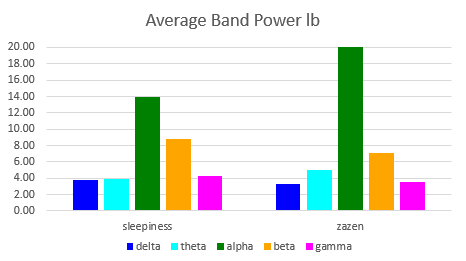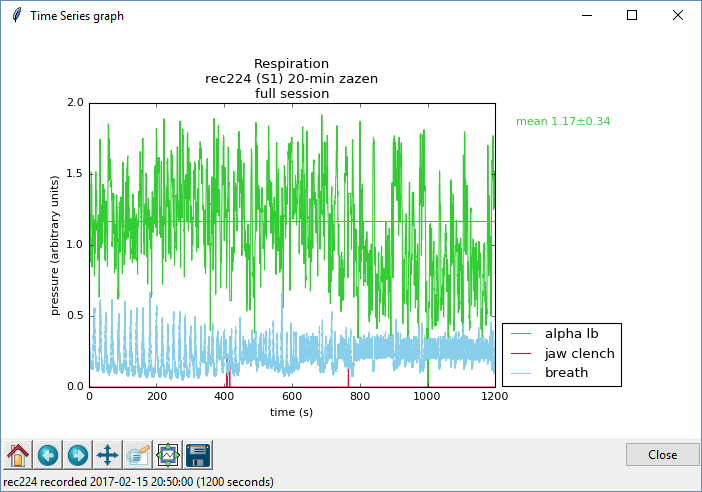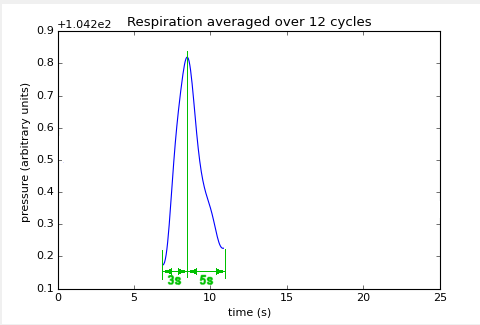A young meditation practitioner (26-year-old, female) joined the September 2016 7-day sesshin at Tahoma Monastery. She had some previous meditation experience, but this was her first time training with Shodo Harada Roshi. Her brainwaves were recorded once while not meditating, and on three occasions while doing zazen. Between September and February, she averaged 4 hrs/day of meditation practice. Recordings were made on:
Sep 7, 2016 – sitting quietly, but not meditating
Sep 7, 2016 – zazen before September osesshin (~600 hours previous meditation experience)
Sep 17, 2016 – zazen after September osesshin (~50 hours additional meditation)
Feb 22, 2017 – zazen after February osesshin (~1300 accumulated hours of meditation experience)
The following features stand out:
- Peaks in the alpha band, recorded at the left rear electrode (TP9) grow stronger with each subsequent zazen period. While not evident in the recording of the non-meditative condition, these peaks appear more pronounced in each successive meditation recording.
- The frequency of eye blinks while meditating is much less than when not meditating. In addition, there seems to be a trend of decreasing eye blink frequency with greater meditation experience.
- At the front sensors (FP1 and FP2) there seems to be growing power in the higher frequency (beta and gamma) bands relative to a lower frequency band (theta) with greater meditation experience.
Peaks in the alpha band become more prominent with zazen practice
First, let us examine the Power Spectral Density charts at the left back sensor (TP9) .

When subject is not meditating, there is no significant peak in the alpha band.
In the first recording, subjects were instructed to meditate for 20 minutes, then to stop meditating for 5 more minutes. When asked if she was able to NOT meditate during the final five minutes, the subject said,
“I think so. I was just trying to think really fast about anything, about things I was trying to remember, to remember things, to recall. And then the whole time I was just making stuff up.”

Small peaks are visible in the alpha band during zazen meditation (before osesshin)
At the end of the period, the subject remarks,
“That was really hard. It made me nervous.”
The next recording was made a week later, at the end of osesshin.

Alpha peaks begin to appear after the osesshin.
Investigator: Have you noticed a change in the quality of your meditation during week?
Subject: Definitely. Completely. I feel like I kind of earned how to meditate, actually. I don’t know. It’s not like I haven’t done it before. But now it’s starting to click now.
Investigator: Was there a kind of a key idea you that you used, or a technique you adjusted to do it?
Subject: Learning how to relax.
Investigator: How to relax?
Subject: Yeah. That’s really hard for me.
The final recording was made 5 months later after a second osesshin. The subject had practiced meditation about 4 hours per day in the intervening time.

Two distinctive peaks appear in the alpha band (5 months after the previous recording).
Investigator: How has this sesshin been going for you?
Subject: It’s been going up and down.
Investigator: How about this particular sitting right now?
Subject: I couldn’t really get into the breathing like I wanted. I couldn’t fully relax. Physically, sitting is still hard for me.
Investigator: So with your breathing, what were you aiming for?
Subject: Comfortable. Something more round. Sort of, that doesn’t feel so forced.
Investigator: But you weren’t finding that in is this round?
Subject: I didn’t really sink into it, but it wasn’t terrible.
Note that there are two distinct peaks two peaks in the alpha band as opposed to just one seen in most other subjects.The significance of this is unknown.
Similar results were obtained for the right back sensor (TP10) :

No alpha peak for the non-meditating condition.

Slight alpha peak during zazen meditation.

Small peaks in the alpha band during zazen (after sesshin).

Pair of clear alpha peaks after the February 2017 osesshin.
Eye blinks become less frequent with meditation practice
The Muse headband automatically records eye blinks. Eye blinks were anti-correlated with meditation–that is, the stronger a person’s meditation focus, the less frequently they blink their eyes. Below are the results for the present practitioner, subject S23:

Frequent eye blinking when not meditating.

Less frequent eye blinks when doing zazen (same recording as above).
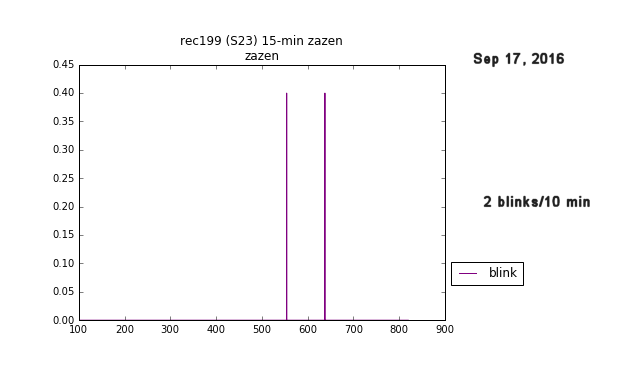
After the September osesshin, eye blinking is substantially reduced.

After the February osesshin, eye blinking has nearly ceased.
Higher frequency bands develop greater power relative to lower frequency bands with greater meditation experience
Radar charts of relative band power for each of the four recordings suggested that higher frequency bands began to dominate lower frequency bands on successive recordings of meditation, after a week-long osesshin and then again after a second osesshin five months later.
 Delta frequency appears to predominate, but this probably due to frequent eye blinking (see spectrogram below). |
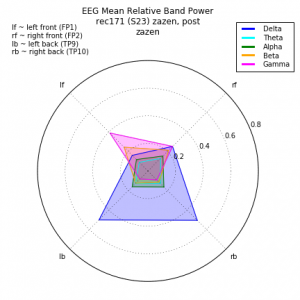 Higher frequencies (gamma and beta) appear at left front electrode (FP1). |
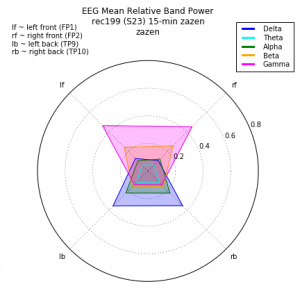 Greater power of beta and gamma in frontal region compared to rear. |
 Beta and Gamma frequencies predominate. |
Frequent blinking masquerades as a delta band signal as can be seen in the correlation between the low frequency patches (below 4 Hz) in yellow-orange of the spectrogram below on which the eye blink signal has been superimposed.

Eye blinks result in registering low-frequency (delta) oscillations so were therefore ignored in the subsequent analysis. See also the post, Sleuthing a delta wave mystery.
To get a better handle on the increase in high frequency oscillations with greater practice, we defined a new parameter which represents the ratio between a stand-in for high frequency (beta power) and a stand-in for low frequency (theta power). Values were normalized to be positive. Results are given below.
 Ratio of beta to theta power when not meditating |
 Ratio of beta to theta power during zazen before first osesshin |
 Ratio of beta to theta power during zazen after the first osesshin |
 Ratio of beta to theta power during zazen after the second osesshin five months later |
The ratio of beta to theta power seems to support the hypothesis of increasing high frequency oscillations in the frontal area with greater zazen practice.



